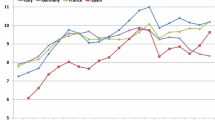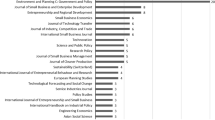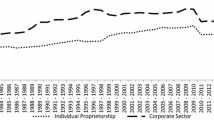Abstract
The paper investigates factors determining the current account in the European Union. In addition to the standard determinants of the current account, explanatory variables describing sectoral composition are included. Independently of the econometric method and data frequency applied, the main findings suggest that the low-productive construction sector might have played an important role in aggravating current account positions in the European economies. On the contrary, business services positively influenced current account balances.

Similar content being viewed by others
Notes
This set of variables is by no means exhaustive, but summarizes well the usual factors included in the empirical investigations concerning specifically industrialized countries, similarly as in Debelle and Faruqee (1996) and Chinn and Prasad (2003). There are also a number of studies, for instance, the panel investigation by Calderón et al. (2002) or a pooled longitudinal estimation by Kahn and Knight (1983) regarding exclusively developing countries, in which also more specific variables are included.
In this sense, the Ricardian equivalence implies that the perfectly foreseeing consumers anticipate the future increase in taxes deriving from the current increase in the government expenditures and answer with higher current savings. This implies no effect of the variation in the government budget on the current account balance.
Provided that nominal prices are fixed in the producer country and the exchange rate pass-through is complete, the ‘expenditure-switching’ effect is valid in the Obstfeld and Rogoff (1995a, 1995b) Redux model.
Recalling ‘thousands of models’ that are supposed to tell ‘one story’, Ca’ Zorzi et al. (2012) make a valuable methodological effort to evaluate different current account models, and find that in the period preceding the actual financial turmoil the fundamentals possessed limited explanatory power over current accounts.
It would be preferable to include in the empirical investigation an explicit category of KIBS. Given, however, the problems with data availability, I apply an ad-hoc classification of services. More precisely, I distinguish between BUSS and non-BUSS, as explained in the next section and in Appendix A1.
The ratio of imports directed toward the sector over its total output accounts on ca 0.12 for construction and 0.07 for services.
Ideally, the focus should be on construction of residential buildings, kept separately from civil engineering. Indeed, the latter is responsible for the creation of infrastructures that play a crucial role for the general business activities. Unfortunately, data are not available at this level of disaggregation, so that in the forthcoming empirical analysis I refer to the entire construction sector. At the same time, however, the anecdotal evidence of the past decades confirms that major movements in the construction sector were due to residential construction.
The US is chosen as a benchmark, given its leading economic position among industrialized countries.
Real effective exchange rates are quoted using the indirect quotation, meaning that an increase (reduction) of the index denotes a real appreciation (depreciation).
Given my focus on productivity, in alternative specifications, I expressed the sectoral variables in terms of total factor productivity (TFP) (levels and growth). These variables were mostly insignificant. This might be due to the fact that by considering only productivity might be insufficient, as it provides limited information on the relative economic importance of a given sector. A VA-share variable is more insightful in this respect. Consequently, if interpreted together with the analysis of data on sectoral productivity, this variable should provide the meaningful qualitative interpretation of the influence on current account.
As confirmed, for instance, by the formal analyses of Balassa (1964) and Samuelson’s (1964).
The choice is also arbitrary to the extent that it considers only exports and not also imports to determine tradability. Whereas in some strands of the literature it might be reasonable to account for imports as well (in order to know whether the price of a product/service is set domestically or rather in the world markets), in the present context it is more straightforward to concentrate on exportable. This is because if a sector is tradable in the sense of being exportable, its contribution to rebalancing the current account will be clearly positive.
See the discussion in Chinn and Prasad (2003) on problems with finding the appropriate instruments for the government budget variable.
The recent economic crises was accounted for in a separate specification by introducing a dummy variable (equal to 1 for the period after 2008 and 0 otherwise), but it was never significant.
The two principal components are those with the highest loading factors, the first with the value of 2.2 and the second 1.0. The two components together manage to explain over 60% of variability of the original variables, whereas the first factor contributed already with 40%. I validated the PCA with the Kaiser–Mexer–Olkin’s measure of sampling adequacy that supported the overall suitability of the data set with a value of 0.6.
The literature is still inconclusive on the validity of the hypothesis. See, for instance, Bagnai (2006) and Kim and Roubini (2008).
References
Arghyrou, MG and Chortareas, G . 2008: Real exchange rate and current account imbalances in the euro area. Review of International Economics 16 (4): 747–764.
Aizenman, J. and Jinjarak, Y . 2009: Current account patterns and national real estate markets. Journal of Urban Economics 66 (2): 75–89.
Bagnai, A . 2006: Structural breaks and the twin deficits hypothesis. International Economics and Economic Policy 3 (2): 137–155.
Balassa, B . 1964: The purchasing-power parity doctrine: A reappraisal. Journal of Political Economy 72 (6): 584–596.
Belke, A and Dreger, C . 2013: Current Account Imbalances in the Euro Area: Does Catching up Explain the Development? Review of International Economics 21 (1): 1–6.
Buiter, WH . 1981: Time preference and international lending and borrowing in an overlapping generations model. Journal of Political Economy 89 (4): 769–797.
Bussière, M, Fratzscher, M and Müller, G.J . 2006: Current account dynamics in OECD countries and in the new EU member states: An intertemporal approach. Journal of Economic Integration 21 (3): 593–518.
Ca’ Zorzi, M, Chudnik, A and Dieppe, A . 2012: Thousand of models, one story: Current account imbalances in the global economy. Journal of International Money and Finance 31 (6): 1319–1338.
Ca’ Zorzi, M and Rubaszek, M . 2012: On the empirical evidence of the intertemporal current account model for the euro area. Review of Development Economics 16 (1): 95–106.
Calderón, CA, Chong, A and Loayza, N . 2002: Determinants of current account deficits in developing countries. Contributions to Macroeconomics 2 (1): 1–31.
Chinn, MD and Ito, H . 2007: Current account balances, financial development and institutions: Assaying the world ‘saving glut’. International Journal of Money and Finance 26 (4): 546–569.
Chinn, MD and Prasad, ES . 2003: Medium-term determinants of current accounts in industrial and developing countries: An empirical exploration. Journal of International Economics 59 (1): 47–76.
De Gregorio, J, Giovannini, A and Wolf, HC . 1994: International evidence on tradables and nontradables inflation. European Economic Review 38 (6): 1225–1244.
De Santis, R and Lührmann, M . 2008: On the determinants of net international portfolio flows: A global perspective. Journal of International Money and Finance 28 (5): 890–901.
Debelle, G and Faruqee, H . 1996: What determines the current account? A cross-sectional and panel approach. IMF Working Paper No. 96/58, International Monetary Fund.
Den Hertog, P . 2000: Knowledge intensive business services as co-producers of innovation. International Journal of Innovation Management 4 (4): 491–528.
Gandolfo, G . 2001: International finance and open-economy macroeconomics. Springer: New York.
Gehringer, A . 2013: Growth, productivity and capital accumulation: The effects of financial liberalization in the case of European integration. International Review of Economics and Finance 25: 291–309.
Gehringer, A . 2015: New evidence on the determinants of current accounts in the EU. Empirica: Journal of European Economics 42 (4): 769–793.
Gete, P . 2009: Housing markets and current account dynamics. University of Chicago, dissertation.
Giavazzi, F and Spaventa, L . 2010: Why the current account matters in a monetary union. CEPR Discussion Paper No. 8008, Centre for Economic Policy Research.
Glick, R and Rogoff, K . 1995: Global versus country-specific productivity shocks and the current account. Journal of Monetary Economics 35 (1): 159–192.
Jaumotte, F and Sodsriwiboon, P . 2010: Current account imbalances in Southern euro area. IMF Working Paper No. WP/10/139, International Monetary Fund.
Kahn, MS and Knight, MD . 1983: Determinants of current account balances of non-oil developing countries in the 1970s: An empirical analysis. IMF Staff Papers 30 (4): 819–842.
Kim, S and Roubini, N . 2008: Twin deficit or twin divergence? Fiscal policy, current account and real exchange rate in the U.S. Journal of International Economics 74 (2): 362–383.
Knedlik, T and von Schweinitz, G . 2012: Macroeconomic imbalances as indicators for debt crises in Europe. Journal of Common Market Studies 50 (5): 726–745.
Lane, PR and Milesi-Ferretti, GM . 2008: The drivers of financial globalization. American Economic Review 98 (2): 327–332.
Lane, PR and Milesi-Ferretti, GM . 2012: External adjustment and the global crisis. Journal of International Economics 88 (2): 252–265.
Macpherson, A . 2008: Producer service linkages and industrial innovation: Results of a twelve-year tracking study of New York State manufacturers. Growth and Change 39 (1): 1–23.
Obstfeld, M and Rogoff, K . 1995a: The intertemporal approach to the current account. In: Grossman, GM and Rogoff, K (eds). Handbook of International Economics, Volume 3. Elsevier: North-Holland pp. 1731–1799.
Obstfeld, M and Rogoff, K . 1995b: Exchange rate dynamics redux. Journal of Political Economy 103 (3): 624–660.
Obstfeld, M. and Rogoff, K . 2009: Global imbalances and the financial crisis: Products of common causes. CEPR Discussion Paper No. 7606.
Punzi, M.T . 2007: The link between housing prices and current account deficit: A study of 10 OECD countries. Boston College, mimeo.
Punzi, M.T . 2013: Housing market and current account imbalances in the international economy. Review of International Economics 21 (4): 601–613.
Rahman, J . 2008: Current account developments in new member states of the European Union: Equilibrium, excess, and EU-phoria. IMF Working Paper No. 92, International Monetary Fund.
Sachs, JD . 1981: The current account and macroeconomic adjustment in the 1970s. Brooking Papers of Economic Activity 1981 (1): 201–268.
Samuelson, PA . 1964: Theoretical notes on trade problems. Review of Economics and Statistics 46 (2): 145–154.
Acknowledgements
The author is thankful to Menzie Chinn, Gian Maria Milesi-Ferretti, Alberto Bagnai, the participants of the Conference ‘Intra-European Imbalances, Global Imbalances, International Banking, and International Financial Stability’ and of the INFER Annual Conference 2013 for their insightful comments and suggestions to the previous version of the paper. The major part of research on the paper has been done when the author was working at the University of Göttingen, Germany.
Author information
Authors and Affiliations
APPENDIX
APPENDIX
A1: Classification of service sectors between BUSS and non-BUSS
For the purpose of the empirical investigation, I distinguish all service sectors in two groups according to the ‘supplier’s role criterion’. To apply this criterion, I calculated the ratio between the sum of the intermediate inputs delivered to the other sectors over the total output produced by that sector for each service sector in each analyzed country and in each year. In the second step, I computed average ratios over time and between countries (electricity, gas and water supply – 0.410; construction – 0.278; wholesale and retail trade – 0.165; transport and storage – 0.463; post and communication – 0.578; financial intermediation – 0.567; real estate – 0.076; renting activities – 0.671; community services – 0.134). Finally, I established 0.3 as a threshold value: the value of the average ratio higher/lower than 0.3 classified a sector as a BUSS/non-BUSS sector. To calculate those ratios, I used World Input–Output Database (WIOD) annual input–output tables.
A2: Tradability and productivity of sectors in four country groups
Applying the methodology by De Gregorio et al. (1994), tradability of industrial sectors has been calculated, as reported inTable A1.
Although a commonly adopted distinction between manufacturing-tradable and services-non-tradable holds, one observation is due here. Within country groups, a certain degree of variability in the calculated measure of tradability can be observed, as expressed by the standard deviation. This confirms the previous intuition that it is difficult to generalize the quality of tradable or non-tradable sectors, as significant differences for particular sectors might sometimes occur across countries. This is, for instance, the case for the renting activities that in France and Germany would be clearly considered as non-tradable (5.8% and 6.4%, respectively), whereas it is tradable in all the remaining countries of the core euro area. Another example refers to the construction sector, which in Hungary and Poland appears to be tradable (14.7% and 14.9%, respectively), whereas it is non-tradable in the rest of the East.
Rights and permissions
About this article
Cite this article
Gehringer, A. Current Accounts in the European Union and the Sectoral Influence: An Empirical Assessment. Comp Econ Stud 58, 152–173 (2016). https://doi.org/10.1057/ces.2016.5
Published:
Issue Date:
DOI: https://doi.org/10.1057/ces.2016.5




